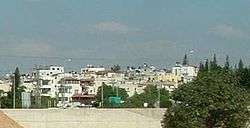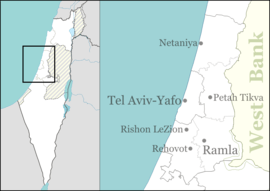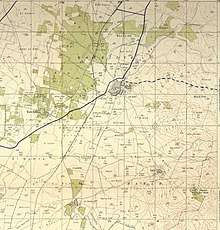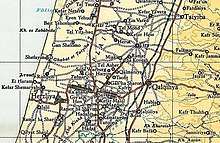Jaljulia
Jaljulia (Arabic: جلجولية, Hebrew: גַ׳לְג׳וּלְיָה), officially also spelled Jaljulye,[4] is an Arab town in Israel near Kfar Saba. In 2019 it had a population of 10,148.[3]
Jaljulia
| |
|---|---|
| Hebrew transcription(s) | |
| • ISO 259 | Ǧalǧúlya |
| • Also spelled | Jaljulye (official) Djaouliyeh,[1] Djeldjoulieh[2] (unofficial) |
 | |
 Jaljulia | |
| Coordinates: 32°09′13″N 34°57′06″E | |
| Grid position | 145/173 PAL |
| District | Central |
| Government | |
| • Type | Local council |
| Area | |
| • Total | 1,900 dunams (1.9 km2 or 500 acres) |
| Population (2019)[3] | |
| • Total | 10,148 |
| • Density | 5,300/km2 (14,000/sq mi) |
History
In Roman times the village was known as Galgulis,[5] while during the Crusader period it was referred to as Jorgilia in 1241 C.E.[6]
In 1265 C.E. (663 H) it is known that the Sultan Baybars allocated equal shares of the village to three of his amirs. One of these, amir Badr al-Din Baktash al-Fakri, included his section of the village in a waqf he established.[7] Excavations of a building close to the Mamluk khan yielded ceramics dating from that period.[8]
Ottoman era
In 1517, the village was included in the Ottoman Empire with the rest of Palestine, and in the 1596 tax-records it appeared located in the nahiya (subdistrict) of Banu Sa´b, part of Sanjak of Nablus, with a population of 100 households ("Khana"), all Muslim. The villagers paid taxes on a number of crops, including wheat and barley, as well as "summer crops", "occasional revenues", "goats and bees", and a market toll. There was also a poll tax, jizya, paid by all the inhabitants in the Sanjak of Nablus. Total taxes were 18,450 akçe, of which 1/6 went to a waqf.[9]
Jaljulia appeared under the name of Gelgeli on Jacotin's map drawn-up during Napoleon's invasion in 1799.[10]
In 1870, Victor Guérin found that the village had six hundred inhabitants.[2] In 1882, the Palestine Exploration Fund's Survey of Western Palestine described it as being a large adobe village on the plain. The mosque was described as fine, but ruined. A ruined Khan was also mentioned. Water was supplied by a well on the west side of the village.[11]
During the Sinai and Palestine Campaign of World War I, the village was on the Ottoman front line and was damaged by British artillery.[12]
British Mandate era
In the 1922 census of Palestine conducted by the British Mandate authorities, Jaljulieh had a population of 123 Muslims,[13] increasing in the 1931 census to 260, still all Muslim, in a total of 60 houses.[14]
By the 1945 statistics, the village had 740 inhabitants, all Muslims.[15] They owned a total of 11,873 dunams of land, while 447 dunams were public. Jews owned 365 dunams of land.[16] A total of 2,708 dunams were for citrus and bananas, 175 dunams for plantations and irrigable land, 9,301 for cereals,[17] while 15 dunams were built-up (urban) land.[18]
After the 1948 war, Jaljulia was on the Arab side of the ceasefire line and its land was confiscated by Israel.[12] It was transferred to Israel in the 1951 armistice agreement but failed to recover its land, which had been given to new Israeli settlements.[12]


Landmarks
The mosque is locally known as Jami Abu´l-Awn, which associates it with the 15th-century religious leader Shams al-Din Abu´l-Awn Muhammad al-Ghazzi, who is known to have come from the town.[19] The architecture of the mosque is, according to Petersen, consistent with a 15th or early 16th century construction date.[20] At present the structure consists of one large vaulted chamber, and three small barrel-vaulted cells. A large second chamber to the west was destroyed by British artillery during World War I.[20]

The khan is opposite the mosque. It was built by Sayf al-Din Tankiz, the governor of Damascus 1312–1340,[21] and it was still functioning in the 16th century, when it was mentioned in an Ottoman firman.[22] In the 19th century it was seen by Guérin, who described it as a beautiful khan with a (ruined) polygonal minaret.[23] Petersen, who surveyed the structure in 1996, found the courtyard entirely overgrown and it was not possible to detect any features within; however, he notes that a 19th-century visitor had mentioned that there was "a great round well" in the centre.[24]
Sports
In 2010, a tennis school was established in Jaljulia by Iman Jabber and Daniel Kessel. In 2011, 50 girls and 20 boys signed up for tennis lessons. The school organizes coexistence matches between Jaljulia and Ra'anana.[25]
Archaeology
An archaeological dig started in 2017 at Jaljulia uncovered, at about a five-meter depth, a half-million-year-old "paradise" for Homo erectus hunter-gatherers, including hundreds of knapped flint hand-axes.[26]According to the Israel Antiquities Authority, recurrent occupation of the site indicates that prehistoric humans possessed a geographic memory of the place and could have returned here as a part of a seasonal cycle.[27]
References
- al-'Ulaymi, 1876, p.148
- Guérin, 1875, pp. 368-369
- "Population in the Localities 2019" (XLS). Israel Central Bureau of Statistics. Retrieved 16 August 2020.
- Palmer, 1881, p.230
- TIR, p. 128, cited Petersen, 2001, p. 175
- Delaville Le Roulx, 1883, p. 176- 177, no. 74; cited in Röhricht, 1893, RHH, p. 286, no 1100; cited in Petersen, 2001, p. 175
- MPF 92, no 20; Cited in Petersen, 2001, p. 178
- Buchendino, 2010, Jaljuliya (Gilgal)
- Hütteroth and Abdulfattah, 1977, p. 140
- Karmon, 1960, p. 170
- Conder and Kitchener, 1882, SWP II, pp. 288-289
- Andrew Petersen (1997). "Jaljuliya: a Village on the Cairo-Damascus Road". Levant. XXIX: 95–114. doi:10.1179/lev.1997.29.1.95.
- Barron, 1923, Table IX, Sub-district of Tulkarem, p. 27
- Mills, 1932, p. 55
- Government of Palestine, Department of Statistics, 1945, p. 20
- Government of Palestine, Department of Statistics. Village Statistics, April, 1945. Quoted in Hadawi, 1970 p. 75
- Government of Palestine, Department of Statistics. Village Statistics, April, 1945. Quoted in Hadawi, 1970, p. 125
- Government of Palestine, Department of Statistics. Village Statistics, April, 1945. Quoted in Hadawi, 1970, p. 175
- Mayer et al., 1950, pp. 29, 37. Cited in Petersen, 2001, p. 177
- Petersen, 2001, p. 178
- According to Maqrizi, cited in Petersen, 2001, p. 178
- Heyd, 1969, p.110. Cited in Petersen, 2001, p. 178
- Guérin, 1875, Samarie II, 368-9. Translated and cited in Petersen, 2001, p. 179
- Ritter, 1866, vol 4, p. 249. Cited in Petersen, 2001, p. 178
- Mixed Doubles, Haaretz
- Beaumont, Peter (7 January 2018). "Stone age hunter-gatherers' 'paradise' discovered next to major Israeli road". The Guardian. Retrieved 7 January 2018.
- Important and Rare Prehistoric Site about Half a Million Years Old Uncovered in Jaljulia in the Sharon Region
Bibliography
- Barron, J.B., ed. (1923). Palestine: Report and General Abstracts of the Census of 1922. Government of Palestine.
- Buchennino, Aviva (2010-09-05). Jaljuliya (Gilgal). Hadashot Arkheologiyot – Excavations and Surveys in Israel.
- Clermont-Ganneau, C.S. (1896). [ARP] Archaeological Researches in Palestine 1873-1874, translated from the French by J. McFarlane. 2. London: Palestine Exploration Fund. ( p.37, p.340)
- Conder, C.R.; Kitchener, H.H. (1882). The Survey of Western Palestine: Memoirs of the Topography, Orography, Hydrography, and Archaeology. 2. London: Committee of the Palestine Exploration Fund.
- Delaville Le Roulx, Joseph (1883). Les archives, la bibliothèque et le trésor de l'Ordre de Saint-Jean de Jérusalem à Malte (in French and Latin). Paris: E. Thorin.
- Government of Palestine, Department of Statistics (1945). Village Statistics, April, 1945.
- Guérin, V. (1875). Description Géographique Historique et Archéologique de la Palestine (in French). 2: Samarie, pt. 2. Paris: L'Imprimerie Nationale.
- Hadawi, S. (1970). Village Statistics of 1945: A Classification of Land and Area ownership in Palestine. Palestine Liberation Organization Research Center.
- Hartmann, Richard (1910): Die Straße von Damaskus nach Kairo Zeitschrift der Deutschen Morgenländischen Gesellschaft › Bd. 64, passim; (Cited in Petersen, 2001)
- Heyd, Uriel (1960): Ottoman Documents on Palestine, 1552-1615, Oxford University Press, Oxford. Cited in Petersen (2001)
- Hütteroth, Wolf-Dieter; Abdulfattah, Kamal (1977). Historical Geography of Palestine, Transjordan and Southern Syria in the Late 16th Century. Erlanger Geographische Arbeiten, Sonderband 5. Erlangen, Germany: Vorstand der Fränkischen Geographischen Gesellschaft. ISBN 3-920405-41-2.
- Karmon, Y. (1960). "An Analysis of Jacotin's Map of Palestine" (PDF). Israel Exploration Journal. 10 (3, 4): 155–173, 244–253.
- Mayer, L.A.; Pinkerfeld, J.; Yadin, Y. (1950). Some Principal Muslim Religious Buildings in Israel. Jerusalem: Ministry of religious affairs. Cited in Petersen (2001)
- Mills, E., ed. (1932). Census of Palestine 1931. Population of Villages, Towns and Administrative Areas. Jerusalem: Government of Palestine.
- MPF: Ipsirli and al-Tamimi (1982): The Muslim Pious Foundations and Real Estates in Palestine. Gazza, Al-Quds al-Sharif, Nablus and Ajlun Districts according to 16th-Century Ottoman Tahrir Registers, Organisation of Islamic Conference, Istanbul 1402/1982. Cited in Petersen (2001).
- Palmer, E.H. (1881). The Survey of Western Palestine: Arabic and English Name Lists Collected During the Survey by Lieutenants Conder and Kitchener, R. E. Transliterated and Explained by E.H. Palmer. Committee of the Palestine Exploration Fund.
- Petersen, Andrew (2001). A Gazetteer of Buildings in Muslim Palestine (British Academy Monographs in Archaeology). 1. Oxford University Press. ISBN 978-0-19-727011-0.
- Ritter, C. (1866). The comparative geography of Palestine and the Sinaitic Peninsula. 4.
- Röhricht, R. (1893). Regesta regni Hierosolymitani (MXCVII-MCCXCI) (in Latin). Berlin: Libraria Academica Wageriana.
- al-'Ulaymi Sauvaire (editor) (1876): Histoire de Jérusalem et d'Hébron depuis Abraham jusqu'à la fin du XVe siècle de J.-C. : fragments de la Chronique de Moudjir-ed-dyn Index: pp 115, 148, 154, 266
External links
- Official website (in Hebrew and Arabic)
- Arabic website
- CBS statistics on Jaljuliya (in Hebrew)
- Welcome To Jaljuliya
- Survey of Western Palestine, Map 14: IAA, Wikimedia commons